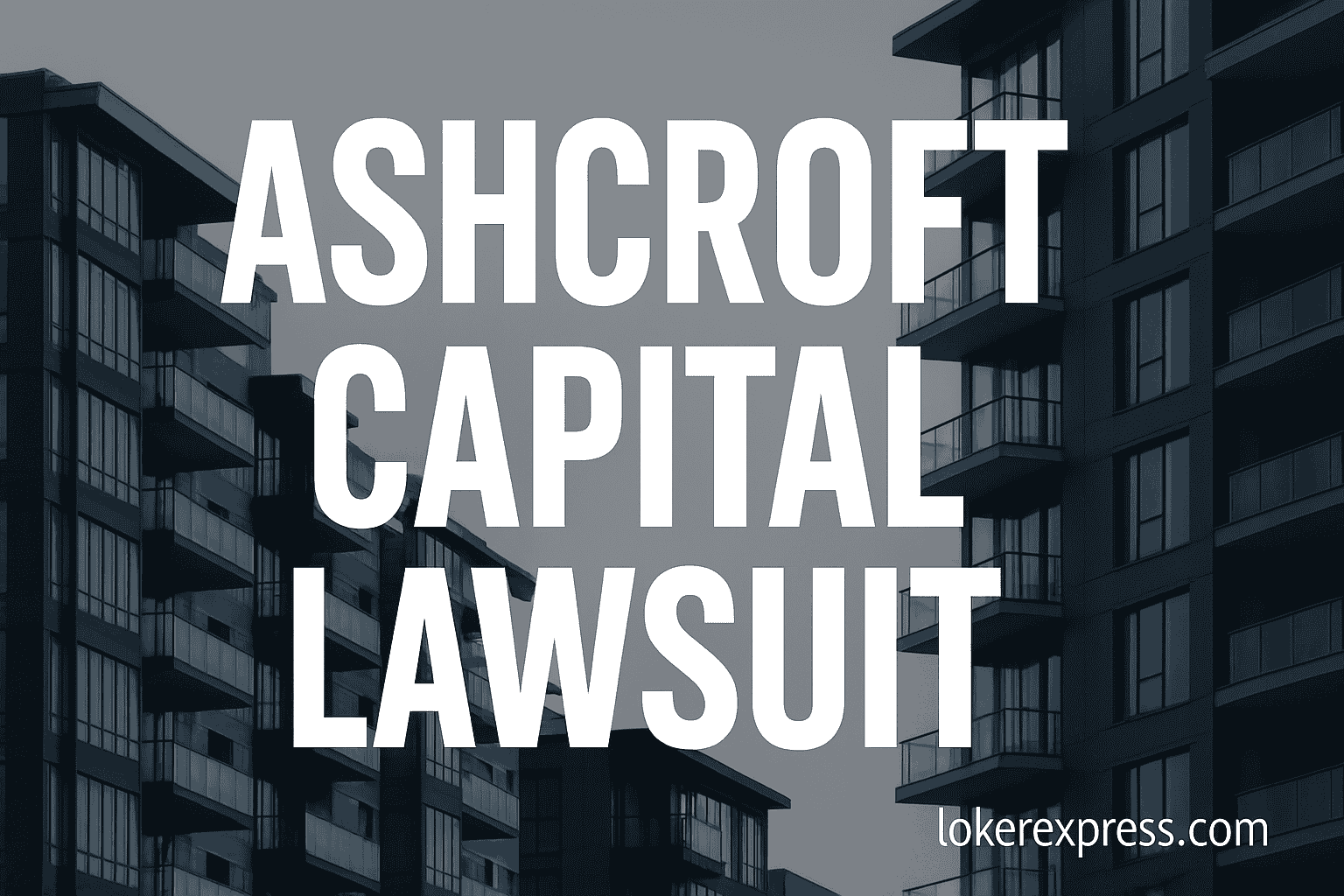Introduction: A Trusted Name Under Scrutiny
Ashcroft Capital, a well-known player in the U.S. multifamily real estate investment space, has been lauded for its value-add strategy and wide network of passive investors. Founded by Joe Fairless and Frank Roessler (who later left the firm), Ashcroft became synonymous with high-yield real estate syndication opportunities. However, in early 2024 and into 2025, the company faced significant legal headwinds due to investor lawsuits alleging serious breaches of trust and fiduciary responsibility. This article breaks down the lawsuit’s core issues, its potential impact, and what it teaches about real estate investing.
Background: Who Is Ashcroft Capital?
Ashcroft Capital has long branded itself as an investor-first company focused on repositioning underperforming multifamily assets. Through syndication, Ashcroft allowed accredited investors to pool funds into properties that were acquired, renovated, and managed with the goal of delivering double-digit returns.
With over $2.7 billion in real estate transactions and tens of thousands of units under management over the years, Ashcroft built a reputation for strong investor relations, frequent educational podcasts (led by co-founder Joe Fairless), and a systematic approach to capital raising. This reputation is what makes the allegations in the current lawsuit especially concerning.
The Lawsuit Emerges: Investor Backlash
In early 2025, multiple Ashcroft Capital investors filed a class action lawsuit in Texas alleging that the firm engaged in misrepresentation, failed to maintain transparency, and breached its fiduciary duties. According to reports from outlets like The Practical Law and WispWillow, investors claim they were not provided timely updates about operational issues and financial underperformance of key properties.
Among the core grievances:
- Overpromised returns that were never realized.
- Delayed or minimal communication about failing assets.
- Poor expense management leading to loss of investor capital.
- Unfavorable refinancing terms.
Some properties reportedly experienced declining occupancy, increasing repair costs, and insufficient rental revenue—leading to lower-than-expected distributions or even none at all.
Misrepresentation of Investment Performance
Investors accuse Ashcroft of painting an overly optimistic picture of projected returns. Marketing materials allegedly forecasted internal rates of return (IRRs) of 15–20%, but actual property performance lagged far behind. In some cases, properties underperformed so significantly that investor capital may have been partially or fully lost.
The lawsuit points to pitch decks and webinars that highlighted strong track records without disclosing potential market risks—such as interest rate hikes or regional rent stagnation. With rising interest rates in 2023 and 2024, many of Ashcroft’s debt-financed acquisitions struggled, and investors were not always informed about these developments in real-time.
Breach of Fiduciary Duty
Ashcroft Capital, as the general partner (GP) in its deals, had a fiduciary duty to act in the best interest of limited partners (LPs). The lawsuit claims this duty was violated when decisions were made that benefited the firm more than the investors.
This includes:
- Charging high asset management fees regardless of property performance.
- Allegedly prioritizing recapitalizations that protected Ashcroft’s equity stake but diluted or endangered LP interests.
- Failure to disclose critical financial issues before raising additional funds from new investors.
These claims have shaken confidence in the GP/LP structure typical in real estate syndications, prompting calls for stronger investor protections.
Transparency Concerns
Transparency—or the lack of it—is a central theme in the lawsuit. Investors say quarterly updates were vague, delayed, or overly sanitized. In many cases, investors learned about serious issues, such as capital shortfalls or missed debt service payments, only after the fact or through unofficial channels.
One property that drew attention was The Avery in Texas. According to Ashcroft’s official update in early 2024, the property required a major recapitalization after cash flows dwindled. Many investors were blindsided by the move, having received only routine performance updates before the announcement.
Ashcroft Capital’s Defense and Public Response
In a February 2024 investor update, Ashcroft called the lawsuit “meritless” and claimed the plaintiffs represented only a small fraction of investors across its portfolio. The firm acknowledged difficult market conditions—particularly rising interest rates and inflation—but denied any wrongdoing or misrepresentation.
Ashcroft also stated that they had recapitalized or sold several properties to protect investor equity and were actively communicating performance metrics. They emphasized that private equity real estate carries inherent risk and that market volatility played a large role in the underperformance.
Broader Impact on Real Estate Syndication
The lawsuit has reverberated across the private real estate investment sector, raising red flags about sponsor integrity, deal structuring, and investor education. Syndication has exploded in popularity in recent years, partly because of its low barrier to entry for passive investors.
However, the Ashcroft case is serving as a cautionary tale:
- Due diligence must go beyond surface-level performance metrics.
- Investors should carefully review fee structures and risk disclosures.
- Passive does not mean disengaged—investor oversight is essential.
As scrutiny increases, it’s likely that regulators like the SEC may look more closely at how syndications are marketed and reported.
Lessons for Investors
Here are several key takeaways for investors considering syndicated real estate deals:
1. Verify Sponsor Track Record
Don’t rely solely on what’s on the sponsor’s website. Ask for full-cycle deal data, references, and actual audited performance reports.
2. Understand the Fee Structure
Fees can eat into returns. Understand acquisition fees, asset management fees, and the GP’s promote structure.
3. Demand Regular, Honest Updates
Sponsors should provide full financial reporting—P&L statements, balance sheets, rent rolls—at least quarterly. Red flags include generic newsletters or inconsistent communication.
4. Watch Market Timing
Deals purchased during ultra-low interest rate environments (like 2021–2022) may struggle to refinance in today’s higher-rate climate. Ask how sponsors are mitigating that risk.
What Happens Next?
As of mid-2025, the lawsuit remains active. Legal teams for both sides are preparing for trial unless a settlement is reached. It’s unclear whether Ashcroft will face monetary penalties, regulatory action, or reputational damage that impacts future fundraising. What’s clear is that this case is already reshaping how sponsors and investors interact.
If Ashcroft is found liable for breaching fiduciary duty or misleading investors, it could set a powerful precedent for how real estate syndications are governed in the U.S.
Read More: Truck Accident Lawyer Animaths.com: Your Trusted Legal Partner After a Crash
Final Thoughts
The Ashcroft Capital lawsuit illustrates the delicate balance between trust and accountability in passive investing. While the firm may ultimately clear its name, the scrutiny it faces has triggered an important industry-wide conversation. For investors, the best defense is a healthy skepticism, rigorous due diligence, and consistent monitoring—even in “hands-off” opportunities.
Disclaimer
The content provided in this article is for informational purposes only and does not constitute legal, financial, or investment advice. While efforts have been made to ensure the accuracy of the information presented, some claims discussed are based on public allegations that are part of ongoing litigation and have not been adjudicated in a court of law. Readers are encouraged to conduct their own research and consult with licensed professionals before making any investment or legal decisions. We are not affiliated with Ashcroft Capital and do not assume any responsibility or liability for actions taken based on the contents of this article.

